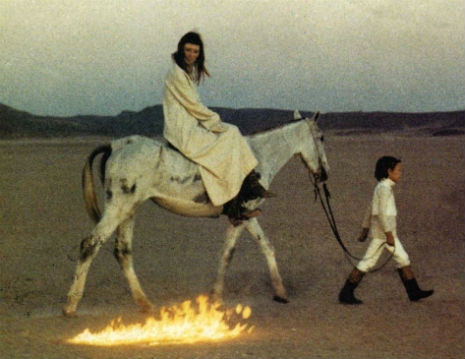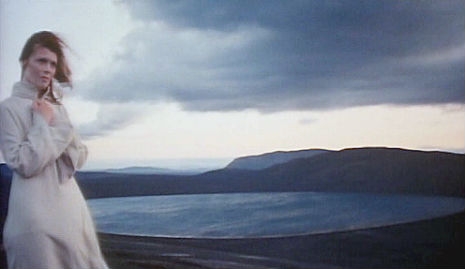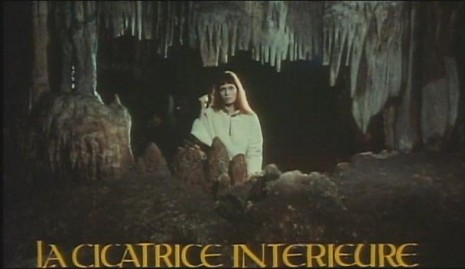
Velvet Underground chanteuse Nico and French avant-garde film director Philippe Garrel had a decade long romantic relationship between 1969 and 1979. Garrel, acclaimed in his youth as being a sort of cinematic Rimbaud, was much admired by Jean-Luc Godard, but is almost completely unknown in the English-speaking world. Nico appeared in seven of his films and sometimes gave him music for them that has not been heard elsewhere. Stills from Garrel’s films appeared on the covers of her Desertshore and The End albums, which show how interested she was in promoting his work. Garrel made his own clothes at the time and began dressing Nico, encouraging her to dye her hair crimson and cut her bangs. Their most significant and fully-realized collaboration was La Cicatrice Intérieure (or “The Inner Scar”), made in 1972 when Garrel was only 22.
During their relationship, the pair became hardcore heroin addicts, resorting to petty thievery from friends and acquaintances to support their habits. According to Richard Witts’ biography, Nico: The Life & Lies of an Icon, their Paris apartment was a “garret” that lacked gas, electricity, hot water, furniture and housed a gargantuan mountain of cigarette butts. The entire apartment was covered in two coats of glossy black enamel paint. Their bed, apparently, was Garrel’s overcoat.

To call Philippe Garrel’s films “tedious” and “self-indulgent” is a bit of an understatement. They’re preposterously tedious and self-indulgent—I believe the Monty Python “French Subtitled Film” sketch was directly inspired by Garrel’s work—but no more so than Matthew Barney’s movies, if you ask me. About half of her Desertshore album (and one otherwise unreleased song, the mind-blowing “König,” see below) is used as the film’s soundtrack. (This again seems worth comparing to Matthew Barney’s Drawing Restraint 9, a collaboration with his wife, Bjork, herself a big Nico fan.)

To some, Garrel, who is still making films today, is an underrated visionary genius whose work must be seen in the cinema to be fully appreciated (for years the director refused to release his films on DVD). To them he is revered as some cinephiles worship John Cassavetes. To others, his films (the ones made during his relationship with Nico at least) look like what two junkies with a camera and the financial backing of a French heiress might get up to…

La Cicatrice Intérieure‘s dialogue, mostly made up right before they’d shoot it, by Nico, consists of existential bitching, basically, as the pair walk around in barren, yet gorgeous landscapes shot in Sinai, Death Valley and Iceland. Garrel uses LONG simple linear tracking shots with minimal editing during scenes. Visually, the film is quite stunning—again think Matthew Barney—but the director forbade subtitles so unless you speak French and German, at a few places you’re bound to be confused. (A Japanese DVD with subtitles popped up in 2005).

Nico does most of the speaking in La Cicatrice Intérieure, moaning throughout the film in her humorless, stentorian voice, at times coming off like some sort of prophetess of doom. As the Time Out reviewer said of the film when it was released in 1972: “You need a bloody big spliff to enjoy this. A miserable couple who you would not wish to meet at a party [Garrel, Nico] are joined by a naked weirdo [Pierre Clémenti, best-known for his role as the gangster lover of Catherine Deneuve’s prostitute in Buñuel’s Belle de jour] with a bow and arrow and a desire to set everything on fire. That’s about it, frankly, unless I fell asleep, which is likely.”
Nico described the film like so:
“[It’s] an important film, a great film. It concerns the fragility of life. The film treats the story of a lunatic who starts to kill all of his sheep. It is not clear if he is a shepherd or a prince. He has no identity until I show up [of course!]. I am a queen on a journey. A queen finds a kingdom wherever she goes. There are more songs than dialogue in the film which I think is a good idea [of course!].
In the case of La Cicatrice Intérieure, she’s probably right about that, and although the film does have its perplexing, often gorgeous, merits, as our own Marc Campbell put it, La Cicatrice Intérieure is “a gorgeous looking folly that, despite its abundant tracking shots, is so inert it makes L’Avventura look like The Fast And The Furious.” La Cicatrice Intérieure is now in the public domain and there is even an HD version of it floating around on the torrent trackers that elevates the viewing experience quite a bit and is worth finding (Hint, looky here). Yet another fine example of an absolutely M.I.A. film that you can see today without even getting up from your seat. La Cicatrice Intérieure was once the litmus test for obscure, nearly impossible to see movies, but there’s even a quite good version of the film on YouTube (see last video).

“My Only Child” and “All That Is My Own” are heard in the following two sequences. The child is Nico’s son, Ari Boulogne. Note how the camera moves constantly.
Nico has some sort of freak-out while Garrel herds some animals. Then we hear “Abschied.”
In the closing moments of Garrel’s La Cicatrice Intérieure we hear “König,” an amazing song Nico recorded during the sessions for Desertshore with John Cale. This version of “König” can only be heard in the film, although Nico re-recorded the number for her 1985 Camera Obscura album.
Bonus clip: Nico and Philippe Garrel met when she contributed this gorgeous (and heard only in the film) version of “The Falconer” to his 1969 film Le Lit de la vierge, which starred Pierre Clémenti as Jesus: